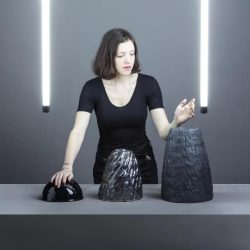1
The 50 Hertz project, which you are presenting at La Vetrina in Venice is a sound installation that combines sound and ceramics. For it to work, you also need water and electricity.
Explain a little more: you studied music and trained as a violinist. Ceramics is another string to your bow. How did you come up with the idea of combining these elements?
During my violin studies, I was as fascinated by the sound produced by open strings as I was by the number of notes the instrument could play. Later, when I was studying art and design, I took up my instrument again to integrate it into a more experimental visual and sound practice that already foreshadowed the sound universe of 50 Hertz and, more broadly, my practice of drone music. My diploma project was a continuation of this research through a sound installation, which I continued to develop in the form of a performance.
At that point, I turned to ceramics for several reasons: I wanted organic shapes that I could interact with and that were the right size for my hands; I needed the conductive and insulating properties of clay and glazes to develop a repertoire of gestures and contacts around ceramics; finally, beyond the practical aspect, ceramics allowed me to develop a specific scenography by making aesthetic choices.
Beyond the practice itself, this complicity between sound and ceramics reveals a deeper dialogue between matter and vibration. Clay, a telluric element, retains within it the memory of gesture and fire; it embodies a dense, tangible materiality. Sound is immaterial, fleeting, elusive, but it possesses a vibratory power that traverses bodies and spaces. By combining the two, 50 Hertz brings together mineral inertia and vibratory fluidity, the solid and the invisible. With Flora Basthier, artist and sound ceramist, we are in the process of creating a label that brings together projects that reflect this thinking.
2
You place your installation in the “drone music” category. Could you give us a definition of that?
In my opinion, drone music is a practice based on continuous sounds that evolve gradually in terms of volume, duration, and additions or subtractions. It is more of a sensory experience than a melodic one. In 50 Hertz, sustained layers reveal harmonics, phase variations, dissonances, and structures between frequencies. Here, the drone acts as an enveloping mass of sound, encouraging introspection and expanded listening.
3
Do you feel that audiences react strongly to your installation 50 Hertz which you subtitled Le Chant du Spectre ? Should we prepare to shiver, tremble, or even more?
Reactions depend on each person’s curiosity and sensitivity. Sometimes, when faced with a lack of understanding of how the device works, some people interpret the sounds through their own knowledge and imagination, which gives rise to beautiful stories. The installation and performance open up a space for the senses, imagination, and contemplation: everyone projects their own perceptions onto it.
The title 50 Hertz refers to the fundamental frequency of domestic alternating current in Europe. When picked up by a sound system (speakers and subwoofer), this frequency manifests itself as a continuous residual noise, often referred to as a buzz. The subtitle Le Chant du Spectre refers to the electromagnetic radiation produced by neon tubes, which causes the buzz to “sing”: this electromagnetic field interferes with the 50 Hz signal and causes variations in phase, amplitude, and harmonic spectrum.
These modulations alter both the timbre and volume of the buzz, transforming a simple parasitic frequency into an evolving sound material. The title 50 Hertz, Le Chant du Spectre poetically refers to this physical phenomenon and its device, giving it a sensitive and imaginary dimension.
4
Through your work, you promote “acoustic ecology,” which enables deep listening. What connection do you want to promote between these two terms, ecology and acoustics?
For me, “acoustic ecology” consists of recognizing that sound is a medium we share, a sensitive space in which we are constantly immersed. It is about becoming aware of this sound environment, perceiving its nuances, and detecting what is added or erased under the effect of dominant noise. Deep listening as conceived by Pauline Oliveros, is in line with this idea: it is a practice of expanded awareness that teaches us to listen to marginal sounds as well as silences, to welcome deep resonances and to open ourselves up to a more refined perception. But beyond a contemplative stance, I also see critical potential in it. In Guerre sonore, Steve Goodman demonstrates how frequencies can become instruments of control or affective mobilization, whether used in a military, media, or entertainment context. This means that sound is not neutral: it has political power, capable of acting on our bodies, emotions, and behaviors.
Acoustic ecology, combined with deep listening, thus becomes a tool: it allows us to regain awareness of our immersion in vibration, to perceive certain forms of sonic alienation, to open up possibilities for emancipation, and to share this collectively. It is through this spectrum that I attempt, on my own scale, to maintain this balance between the poetic sensitivity of sound and an awareness of its critical power.


